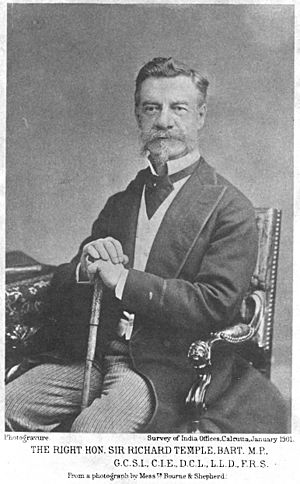Sir Richard Temple, 1st Baronet facts for kids
Quick facts for kids
Sir Richard Temple
|
|
|---|---|
 |
|
| Governor of Bombay | |
| In office 1877–1880 |
|
| Preceded by | Sir Philip Wodehouse |
| Succeeded by | Sir James Fergusson |
| Personal details | |
| Born | 8 March 1826 |
| Died | 15 March 1902 (aged 76) |
| Alma mater | East India Company College |
Sir Richard Temple, 1st Baronet (born March 8, 1826 – died March 15, 1902) was an important British leader in India during the 1800s. He worked as a colonial administrator, which meant he helped manage the areas that were part of the British Empire. He was the Governor of Bombay (now Mumbai) from 1877 to 1880.
Contents
Early Life and Education
Richard Temple was born in 1826. His father was also named Richard Temple. The family had a long history, and his ancestors had lived in a manor house called The Nash in Worcestershire, England, for many years. Richard inherited this family estate when his father passed away in 1874.
He went to Rugby School, a famous school in England. After that, he studied at the East India Company College at Haileybury. This college trained people to work for the East India Company, which was a powerful British trading company that also governed parts of India.
Career in India
In 1846, Richard Temple joined the Bengal Civil Service. This was a group of British officials who helped run the Bengal region of India. He quickly became known for his hard work and good writing skills. For several years, he worked as a private secretary for John Lawrence in the Punjab. He also gained valuable experience with money matters while working with James Wilson.
Temple became the Chief Commissioner for the Central Provinces of India. This was a high-ranking job where he was in charge of a large area. In 1867, he moved to Hyderabad as the Resident, another important role. That same year, he was given a special honor, becoming a Knight Commander of the Order of the Star of India. In 1868, he joined the main government of India. He first served as the foreign secretary, dealing with other countries, and then as the finance minister, managing the government's money.
Fighting Famine
In 1874, Richard Temple became the Lieutenant-Governor of Bengal Presidency. During this time, a terrible famine hit the region. A famine is when there is not enough food for everyone, leading to widespread hunger and death. Temple acted quickly to prevent many people from dying. He arranged for half a million tons of rice to be brought in from British Burma. This helped a lot of people who were starving. This was one of the few times the British government provided a good amount of help during a famine.
Later, in 1877, another famine happened in Madras. Temple was sent there to help. He tried new ways to provide relief. He set up work camps where people could build railroads and canals. However, the food provided, known as the "Temple wage," was very small. Workers received only about one pound of rice a day, which was not enough to keep them healthy, especially for those doing hard physical labor.
Governor of Bombay
Because of his service, Richard Temple was given the title of baronet in 1876. This is a special honor from the British Crown. In 1877, he became the Governor of Bombay Presidency. He worked tirelessly during the Second Anglo-Afghan War from 1878 to 1880.
In 1880, as his time in India was ending, people decided to build a statue to honor his 33 years of service. The marble statue was finished in 1884. It showed him in his formal uniform as a Grand Commander of the Star of India. The statue was first placed in Bombay and later moved to the Bhau Daji Lad Museum.
Life After India
After returning to England, Richard Temple became a MP for the Conservative Party in 1885. He represented the Evesham area of Worcestershire. He also wrote several books about India. In Parliament, he spoke often about Indian topics, as he was an expert. He was known for his unique appearance, which was often exaggerated in cartoons in Punch magazine.
In 1885, he became the vice-chairman of the London School Board, which managed schools in London. He did important work there, especially with the finance committee. In 1892, he changed his parliamentary area to Kingston, but he retired from politics in 1895. In 1896, he was made a Privy Councillor, another high honor.
Sir Richard Temple passed away on March 15, 1902, at his home in Hampstead, due to heart failure.
His Family
Sir Richard Temple was married twice. His first wife was Charlotte Frances Martindale, whom he married in 1849. She died in 1855, and they had three children:
- Richard Carnac Temple, 2nd Baronet (1850–1931)
- Lieutenant-Colonel Henry Martindale Temple (1853–1905), who worked in diplomacy
- Edith Frances Temple (1855–1933)
In 1871, he married Mary Augusta Lindsay. She was also from a family involved in the Indian Civil Service. Lady Temple received an honor called the Companion of the Order of the Crown of India in 1878. She died in 1924. They had one son together:
- Charles Lindsay Temple (1871–1929), who later became the Lieutenant-Governor of Northern Nigeria.
Images for kids


